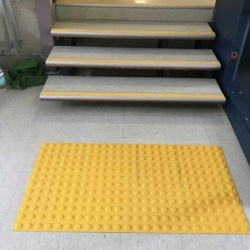









In today's fast-paced world, accessibility and inclusion have become paramount for the design of public and private built environments. With rising advocacy, various levels of government in Canada have enacted comprehensive accessibility legislation to ensure buildings and exterior spaces are barrier-free for people of all abilities. As a leading Canadian provider of code-compliant tactile solutions, we at Tactile Solution Canada recognize the importance of continually evolving our offerings to meet the dynamic needs of architects, designers, and end-users.
This blog explores innovative ways to amplify accessibility through thoughtful integration of tactile technology and innovative assisted navigation systems. We discuss the latest options available to enhance wayfinding via multiple sensory modalities like touch, vision, and hearing. The goal is to create intuitive, welcoming built environments that empower independent mobility for diverse communities through multi-sensory guidance.
Before diving into specific solutions, it is prudent to discuss human-centric design principles. As per AODA and the National Building Code of Canada (NBC), facilities must consider diverse physical, sensory, and cognitive abilities during planning and construction. A holistic, user-focused approach involves deeply understanding how various limitations and needs shape navigation behaviors.
For example, vision impairment necessitates highly contrasting, distinguishable tactile textures for hazard detection and directional cues. Subtle cues may go unnoticed. Similarly, some learning or cognitive disabilities benefit from supplementary audio instructions paired with visual/tactile wayfinding. Designing with diverse human factors in mind leads to more intuitive, inclusive spaces nurturing dignity and participation for all.
Standard tactile walking surface indicators (TWSIs) like truncated domes and wayfinding bars per CSA B651 remain the cornerstone of accessible design and continue enhancing safety under the AODA. Some innovative options now available include:
Porcelain tactile tiles offer aesthetic elegance with durability for demanding environments.
Photoluminescent (PL) stair nosings and exit path markings visible in emergencies per NFPA 101.
Rigid polymer and rubber domes/bars cuttable to custom contours for unique architectural features.
Friction-enhanced, anti-slip surfaces upgrading safety on stairs/ramps as per IFC.
Proper specification and installation as per manufacturer guidelines ensure longevity and accessibility compliance throughout a facility's lifecycle. Periodic inspection maintains the continuity of circulation paths.
While tactile remains the universal standard, complementary technologies now aid navigation for those preferring multi-sensory modalities:
Indoor navigation apps integrating building Floor Plans, augmented reality (AR) overlays, and turn-by-turn voice instructions.
Bluetooth beacons paired with smartphone apps broadcasting location-specific audio describing nearby points of interest.
Smart glasses displaying AR directions/text on camera view for the visually impaired or those unable to look down at phones.
Echo locate apps utilizing echolocation by interpreting clicks or snaps bounced off surfaces as navigational cues similar to bats or dolphins.
Wearable vibrotactile systems providing navigation via patterns of vibrations on the wrist indicative of direction (left/right).
Public facilities are now experimenting with modular, scalable smart accessories discreetly installed and remotely managed via cloud-based monitoring for reliability. As battery/network technologies evolve, assistive possibilities continue expanding.
Fully leveraging both sensory modalities optimizes wayfinding support. Some integration strategies are:
Augmenting traditional tactile TWSIs with embedded RFID or QR codes enabling AR/audio overlays activated by smartphones for those preferring multi-sensory navigation.
Installing beacons near points of interest, triggering AR directions/labels on smart glasses worn by visitors with low or no vision.
Strategically pairing vibrotactile bracelets or smartwatches providing directional feedback with building app routes plotted atop floor plans for indoor navigation.
Integrating echolocation apps with distinctive acoustic textures on critical TWSIs uniquely identifiable solely by echo bounce patterns.
Deploying Bluetooth beacons near large Braille/text displays on interactive directories for broadcasting descriptions to nearby visually impaired audiences.
Seamless coordination of multiple guidance methods leads to enhanced accessibility and welcomes diverse navigation styles under one inclusive built experience. The future of wayfinding lies in such harmonized sensory integration.
In summary, thoughtful integration of tactile technologies and assisted navigation elevates accessibility. A holistic, user-focused approach nurtures inclusive, intuitive circulation for diverse communities. Tactile Solution Canada remains committed to pioneering innovative, code-compliant tactile solutions that enable independence and dignity for all. Please reach out should you require guidance on accessibility upgrades leveraging the synergies of code-compliant tactile.
A. While rapidly evolving, most assisted technologies remain supplementary rather than replacements for universal tactile standards. TWSIs engineered for rigorous durability ensure fail-safe compliance. Complementary tech aids should not compromise safety.
A. Beacons paired with directional vibrotactile systems or echolocation apps aid outdoor mobility. Porcelain tactiles endure demanding situation. AR overlaying critical infrastructure improves the accessibility of large public sites with sparse navigation options.
A: Retrofitting assisted tech into legacy structures presents unique challenges, but many solutions exist. For instance, RFID/beacon modules are discreetly mounted on existing TWSIs without impeding detectability. Outdoor apps augment circulation paths on site maps without facility upgrades. With creative planning, enhanced wayfinding benefits all.
A. Integration should never compromise compliance with accessibility standards. Tactile cues meeting rigors of CSA B651, IFC, NBC, etc., serve as a baseline. Assisted options provide supplementary support without replacing or jeopardizing the fail-safe universality of standardized tactile indicators as mandated. Creative solutions optimize multi-sensory guidance under compliance.
